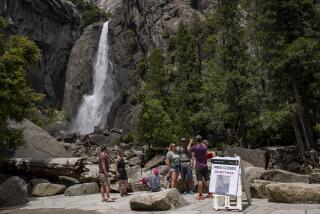Preserving Yosemite
- Share via
Robert Jones was right in his column (“Preserving the Progress at Yosemite,” Part A, Jan. 23): All of us want the status quo in Yosemite. But he was wrong about how to keep it.
Since the summer of 1967, when Jones discovered the wonder that is Yosemite, the annual number of visitors at Yosemite has climbed from 2.2 million to 3.4 million. Though regular visitors may not notice the year-to-year change, the congestion at Yosemite brought about by that more than 50% increase in visitation certainly has worsened over the past 23 years. As Jones acknowledged, at certain times the west entrance to the valley has had to be sealed.
Yosemite is such an extraordinary place that we have not yet ruined it. But if the trends of greater congestion and commercialization are not checked, then we surely will. Recognizing the threats posed by these trends, the National Park Service drew up a management plan 10 years ago. It was ambitious. Automobile traffic would be scaled back. Facilities would be placed outside the park. Armies of administrative personnel would no longer be kept in the heart of Yosemite Valley.
Of course, not a single one of these ideas has been implemented. And now, as the Park Service reviews that 1980 plan, there is concern that the document may be scaled back. But a retreat would be a colossal mistake. A primary reason why cars and exhaust have not yet destroyed the valley is the shuttle bus system that was put in place in 1970 and subsequently expanded. As visitation grows, so must the shuttle. The last thing that Yosemite needs is the added parking lots proposed by the Park Service and the concessionaire, the Curry Co.
Because Yosemite is facing the problem of congestion before almost any other national park, the actions taken there will provide guidance for the others.
The only way that our children and grandchildren will have a chance to enjoy the Yosemite that Jones discovered in 1967 is for the Park Service to look ahead and confront the problems that the park’s growing visitation will bring. In this centennial year, the Park Service must do what it talked about doing 10 years ago.
GAYLORD NELSON
Wilderness Society
Washington, D.C.
Nelson, a former U.S. senator from Wisconsin, was the founder of Earth Day.
More to Read
Sign up for The Wild
We’ll help you find the best places to hike, bike and run, as well as the perfect silent spots for meditation and yoga.
You may occasionally receive promotional content from the Los Angeles Times.






